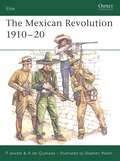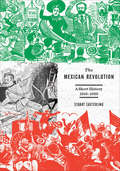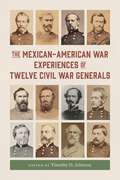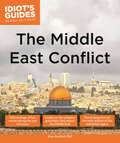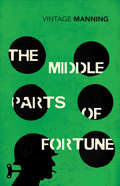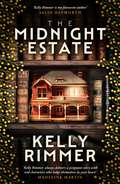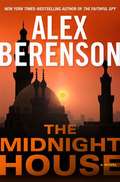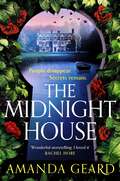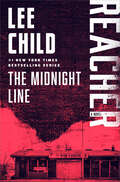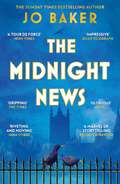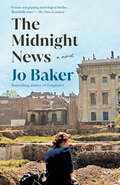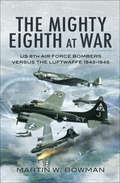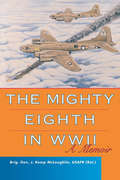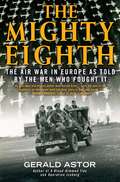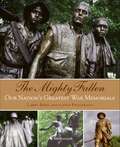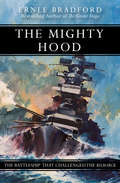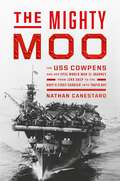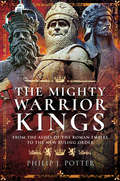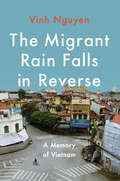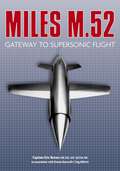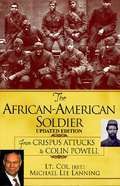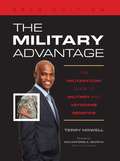- Table View
- List View
The Mexican Revolution 1910-20
by Stephen Walsh Philip JowettSome of the most famous Western movies have been set against the background of the Mexican Revolution of the early 20th century. Now, for the first time in English, Osprey offer a concise but fact-packed account of the events, armies, uniforms and weapons of those ten chaotic and bloody years, putting in context such famous but half-understood names as Diaz, Pancho Villa, Zapata, Madero and Huerta. The text is illustrated with many rare and fascinating period photographs, and with eight detailed color plates of orfiristas and Rurales, Maderisitas, Federales, Villistas, Zapatistas,and US volunteers and intervention troops.
The Mexican Revolution: A Short History, 1910-1920
by Stuart Easterling&“An excellent account and analysis of the Mexican Revolution, its background, its course, and its legacy . . . an important contribution [and] a must read!&” (Samuel Farber, author of Cuba Since the Revolution of 1959). The most significant event in modern Mexican history, the Mexican Revolution of 1910-20 remains a subject of debate and controversy. Why did it happen? What makes it distinctive? Was it even a revolution at all? In The Mexican Revolution, Stuart Easterling offers a concise chronicle of events from the fall of the longstanding Díaz regime to Gen. Obregón&’s ascent to the presidency. In a comprehensible style, aimed at students and general readers, Easterling sorts through the revolution&’s many internal conflicts, and asks whether or not its leaders achieved their goals.
The Mexican-American War Experiences of Twelve Civil War Generals (Conflicting Worlds: New Dimensions of the American Civil War)
by Timothy B. Smith Joseph T. Glatthaar Craig L. Symonds Brian Steel Wills Jennifer M. Murray T. Michael Parrish Sean Chick Dr Thomas W. Cutrer Dr Christian B. Keller Dr Alexander Mendoza Dr Ethan S. Rafuse Dr Stephen D. Engle Dr Cecily N. ZanderLong overshadowed by the American Civil War, the Mexican-American War (1846–1848) has received significantly less attention from historians partly because of its questionable origin and controversial outcome. Rather than treat the conflict with a form of historical amnesia, the contributors to this volume argue that the Mexican-American War was a formative experience for the more than three hundred future Civil War generals who served in it as lower-grade officers. The Mexican War was the first combat experience for many of them, a laboratory that equipped a generation of young officers with practical lessons in strategy, tactics, logistics, and interpersonal relationships that they would use later to command forces during the Civil War.
The Middle East Conflict (Idiot's Guides)
by Alan AxelrodThe Middle East is often a pressure cooker of upheaval and the threat of war. Complex dynamics are at work, both culturally and politically, and understanding conflict in this region starts with understanding both recent and ancient events. Noted history writer, Alan Axelrod, PhD, breaks down the stereotypes and biases and helps readers not only understand what has been happening during the last 100 years, but why it has happened, who was involved, and what might happen in the future. Supplemental maps are also included.
The Middle Parts of Fortune: Somme And Ancre 1916
by Frederic Manning'They can say what they bloody well like, but we're a fuckin' fine mob.'Deep in the mud, stench of the Somme, Bourne is trying his best to stay alive. There he finds the intense fraternity of war and fear unlike anything he has ever known.Frederic Manning's novel was first published anonymously in 1929. The honesty with which he wrote about the horror, the boredom, and the futility of war inspired Ernest Hemingway to read the novel every year, 'to remember how things really were so that I will never lie to myself nor to anyone else about them.
The Middlebrook Guide to the Somme Battlefields: A Comprehensive Coverage from Crécy to the World Wars
by Martin Middlebrook Mary MiddlebrookWhile best known as being the scene of the most terrible carnage in the WW1 the French department of the Somme has seen many other battles from Roman times to 1944. William the Conqueror launched his invasion from there; the French and English fought at Crecy in 1346; Henry Vs army marched through on their way to Agincourt in 1415; the Prussians came in 1870.The Great War saw three great battles and approximately half of the 400,000 who died on the Somme were British a terrible harvest, marked by 242 British cemeteries and over 50,000 lie in unmarked graves. These statistics explain in part why the area is visited year-on-year by ever increasing numbers of British and Commonwealth citizens. This evocative book written by the authors of the iconic First Day on the Somme is a thorough guide to the cemeteries, memorials and battlefields of the area, with the emphasis on the fighting of 1916 and 1918, with fascinating descriptions and anecdotes.
The Midnight Estate: a captivating mystery by the bestselling author of THE THINGS WE CANNOT SAY
by Kelly Rimmer'A stunning novel full of heart, hope and enduring love in all its forms. A heart-wrenching mystery to savour' AMANDA GEARD, author of The Midnight HouseA crumbling mansion, a forgotten book, and the mystery that could destroy them all . . .In the aftermath of a tumultuous year, Fiona Winslow finds solace in the decaying grandeur of Wurimbirra, the rambling family estate on Australia's east coast. Intent on restoring it - despite her mother's objections - Fiona discovers the keys to more than just the dilapidated country mansion, but a secret buried for generations.When a book, The Midnight Estate, catches her attention, Fiona is plunged into a tale that mirrors her own life - a story of love, loss and betrayal. She dismisses the similarities as coincidence, but as she's drawn deeper into the story, the lines between fiction and reality blur, and Fiona must ask herself: how well does she know her own family?A gothic epic that spans generations, The Midnight Estate is a chilling journey through a family's darkest secrets, and the haunting echoes they leave behind.'A mesmerizing read which had me glued to the pages from beginning to end. Absorbing, important, impactful, this will stay with me' LOUISE FEIN'Kelly Rimmer always delivers a poignant story with real characters who lodge themselves in your heart' MADELINE MARTIN'A book within a book that explores the weight of family secrets and extraordinary acts of humanity in equal measure . . . an emotional, haunting tale' JULIA KELLY
The Midnight House (John Wells Series #4)
by Alex BerensonEarly one morning, a former CIA agent is shot to death in the street. That night, an army vet is gunned down in his doorway. The next day, John Wells gets a phone call. Come to Langley. Now. The two victims were part of an eleven-member interrogation team that operated out of a secret base in Poland called the Midnight House. For two years, they put the screws to the toughest jihadis, men thought to have knowledge of imminent threats. The interrogators used whatever means necessary. When they were disbanded in the wake of public controversy, they were given medals for their heroism, Prozac for their nightmares. Now Wells must find out who is killing them. Islamic terrorists are the likeliest explanation, and Wells is uniquely qualified to go undercover after them. But the trail of blood he discovers will lead him and his boss, Ellis Shafer, to a place they wouldn't have imagined-and leave Wells facing the hardest of questions about the men of the Midnight House.
The Midnight House: A spellbinding big house mystery set in beautiful Ireland and WW2 London for lovers of historical fiction
by Amanda GeardPeople disappear. Secrets remain...'A wonderful tale of family secrets. Compelling, intriguing, and brimming with lush historical detail' HAZEL GAYNOR, New York Times bestselling author of The Bird in the Bamboo Cage'I really, really loved it. Written in that old-school, descriptively beautiful way I just love and adore. A wonderful mystery, and then another mystery thrown in, totally atmospheric and just wonderfully escapist' LORNA COOK, USA Today bestselling author of The Girl from the Island_________________________My Dearest T, Whatever you hear, do not believe it for a moment...1940: In south-west Ireland, the young and beautiful Lady Charlotte Rathmore is pronounced dead after she mysteriously disappears by the lake of Blackwater Hall. In London, on the brink of the Blitz, Nancy Rathmore is grieving Charlotte's death when a letter arrives containing a secret that she is sworn to keep - one that will change her life for ever.2019: Decades later, Ellie Fitzgerald is forced to leave Dublin disgraced and heartbroken. Abandoning journalism, she returns to rural Kerry to weather out the storm. But, when she discovers a faded letter, tucked inside the pages of an old book, she finds herself drawn in by a long-buried secret. And as Ellie begins to unravel the mystery, it becomes clear that the letter might hold the key to more than just Charlotte's disappearance.An unforgettable and spellbinding story of secrets, war, love and sacrifice, perfect for readers of Kate Morton, Eve Chase and Louise Douglas.(P) 2022 Headline Publishing Group Ltd
The Midnight House: Curl up with this rich, spellbinding Richard and Judy Book Club read of love and war
by Amanda GeardThe spellbinding RICHARD AND JUDY BOOKCLUB PICK about a mysterious house and an old family secret . . .'Wonderful storytelling. I loved it' RACHEL HORE'A wonderful tale of family secrets, brimming with lush historical detail' HAZEL GAYNOR'A mesmerising debut novel, lush and gorgeous, with a rich family tale to tell' RICHARD AND JUDY BOOK CLUB _______ People disappear. Secrets remain . . . 1940: In south-west Ireland, the young and beautiful Lady Charlotte Rathmore is pronounced dead after she mysteriously disappears by the lake of Blackwater Hall. In London, on the brink of the Blitz, Nancy Rathmore is grieving Charlotte's death when a letter arrives containing a secret that she is sworn to keep - one that will change her life for ever. 2019: Disgraced young journalist Ellie Fitzgerald flees Dublin for the safety of rural Kerry. When she discovers a faded letter, tucked inside the pages of an old book from Blackwater Hall, she finds herself drawn in by the mystery of Lady Charlotte's disappearance, and uncovers a long-buried secret...Sweeping from the wilds of beautiful Ireland to wartime London, this is perfect for fans of Kate Morton, Eve Chase and Lucinda Riley.** DON'T MISS THE NEW NOVEL FROM AMANDA GEARD, THE MOON GATE, AVAILABLE NOW ** _______ 'I was pulled in from page one. It's beautiful' LIZ FENWICK'A mystery spanning generations, evocative and beautifully written' TRACEY REES'I really loved it. A wonderful mystery. Atmospheric and wonderfully escapist' LORNA COOK 'A gorgeous setting, wonderful characters and secrets that kept me glued to the pages' JENNY ASHCROFT 'Intriguing, moving and I loved the way the stories moved back and forth in time' SINÉAD MORIARTYReal readers adore this book... '⭐ ⭐ ⭐ ⭐ ⭐Love love love this book! Fabulous female characters. I was totally invested in the story. I couldn't wait to get back to it' '⭐ ⭐ ⭐ ⭐ ⭐I was absolutely captivated. Wonderful and rich. I couldn't put it down' '⭐ ⭐ ⭐ ⭐ ⭐'A wonderful read and a spellbinding mystery with wonderful characters that leap off the page. This was beautifully written with the story spanning generations' '⭐ ⭐ ⭐ ⭐ ⭐'I have been completely immersed and unwilling to put this one down. This is an absolute gem and a must. A beautiful story' '⭐ ⭐ ⭐ ⭐ ⭐'I've been reading a lot of dual time books, and this one has to be up there with the best . . . a brilliant read'
The Midnight House: Curl up with this rich, spellbinding Richard and Judy Book Club read of love and war
by Amanda GeardThe spellbinding RICHARD AND JUDY BOOKCLUB PICK about a mysterious house and an old family secret . . .'Wonderful storytelling. I loved it' RACHEL HORE'A wonderful tale of family secrets, brimming with lush historical detail' HAZEL GAYNOR'A mesmerising debut novel, lush and gorgeous, with a rich family tale to tell' RICHARD AND JUDY BOOK CLUB _______ People disappear. Secrets remain . . . 1940: In south-west Ireland, the young and beautiful Lady Charlotte Rathmore is pronounced dead after she mysteriously disappears by the lake of Blackwater Hall. In London, on the brink of the Blitz, Nancy Rathmore is grieving Charlotte's death when a letter arrives containing a secret that she is sworn to keep - one that will change her life for ever. 2019: Disgraced young journalist Ellie Fitzgerald flees Dublin for the safety of rural Kerry. When she discovers a faded letter, tucked inside the pages of an old book from Blackwater Hall, she finds herself drawn in by the mystery of Lady Charlotte's disappearance, and uncovers a long-buried secret...Sweeping from the wilds of beautiful Ireland to wartime London, this is perfect for fans of Kate Morton, Eve Chase and Lucinda Riley.** DON'T MISS THE NEW NOVEL FROM AMANDA GEARD, THE MOON GATE, AVAILABLE NOW ** _______ 'I was pulled in from page one. It's beautiful' LIZ FENWICK'A mystery spanning generations, evocative and beautifully written' TRACEY REES'I really loved it. A wonderful mystery. Atmospheric and wonderfully escapist' LORNA COOK 'A gorgeous setting, wonderful characters and secrets that kept me glued to the pages' JENNY ASHCROFT 'Intriguing, moving and I loved the way the stories moved back and forth in time' SINÉAD MORIARTYReal readers adore this book... '⭐ ⭐ ⭐ ⭐ ⭐Love love love this book! Fabulous female characters. I was totally invested in the story. I couldn't wait to get back to it' '⭐ ⭐ ⭐ ⭐ ⭐I was absolutely captivated. Wonderful and rich. I couldn't put it down' '⭐ ⭐ ⭐ ⭐ ⭐'A wonderful read and a spellbinding mystery with wonderful characters that leap off the page. This was beautifully written with the story spanning generations' '⭐ ⭐ ⭐ ⭐ ⭐'I have been completely immersed and unwilling to put this one down. This is an absolute gem and a must. A beautiful story' '⭐ ⭐ ⭐ ⭐ ⭐'I've been reading a lot of dual time books, and this one has to be up there with the best . . . a brilliant read'
The Midnight Line: A Jack Reacher Novel (Jack Reacher #22)
by Lee Child#1 NEW YORK TIMES BESTSELLER • Lee Child returns with a gripping powerhouse thriller featuring Jack Reacher, &“one of this century&’s most original, tantalizing pop-fiction heroes&” (The Washington Post).Don&’t miss the hit streaming series Reacher!Reacher takes a stroll through a small Wisconsin town and sees a class ring in a pawn shop window: West Point 2005. A tough year to graduate: Iraq, then Afghanistan. The ring is tiny, for a woman, and it has her initials engraved on the inside. Reacher wonders what unlucky circumstance made her give up something she earned over four hard years. He decides to find out. And find the woman. And return her ring. Why not?So begins a harrowing journey that takes Reacher through the upper Midwest, from a lowlife bar on the sad side of small town to a dirt-blown crossroads in the middle of nowhere, encountering bikers, cops, crooks, muscle, and a missing persons PI who wears a suit and a tie in the Wyoming wilderness.The deeper Reacher digs, and the more he learns, the more dangerous the terrain becomes. Turns out the ring was just a small link in a far darker chain. Powerful forces are guarding a vast criminal enterprise. Some lines should never be crossed. But then, neither should Reacher.BONUS: Includes a sneak peek of Lee Child&’s novel Past Tense.
The Midnight News
by Jo BakerIt is 1940 and twenty-year-old Charlotte Richmond watches from her attic window as enemy planes fly over London. Still grieving her beloved brother who never returned from France, she is working hard to keep her own little life ticking over: holding down a dull typist job at the Ministry of Information, sharing gin and confidences with her best friend Elena, and dodging her difficult father. She has good reason to keep her head down and stay out of trouble. She knows what happens when she makes a nuisance of herself.On her way to work she often sees the boy who feeds the birds - a source of unexpected joy amidst the rubble of the Blitz. But every day brings new scenes of devastation, and after yet another heartbreaking loss Charlotte has an uncanny sense of foreboding. Someone is stalking the darkness, targeting her friends. And now he is following her.She no longer knows who to trust. She can't even trust herself. She knows this; her family have told so her often enough. As grief and suspicion consume her, Charlotte's nerves become increasingly frayed, and soon her very freedom is under threat . . .Riveting and deeply moving, The Midnight News is a tour de force from Sunday Times bestselling author Jo Baker - a breathtaking story of friendship, love and war.
The Midnight News: A novel
by Jo BakerFrom the best-selling author of Longbourn, a gripping novel of one young woman&’s unraveling during the Blitz—a story of World War II intrigue, love, and danger • &“[A] thrilling novel…atmospheric and memorable.&” —Emma Donoghue, best-selling author of HavenIt is 1940 and twenty-year-old Charlotte Richmond watches from her attic window as enemy planes fly over London. Still grieving her beloved brother, who never returned from France, she is trying to keep herself out of trouble: holding down a typist job at the Ministry of Information, sharing gin and confidences with her best friend, Elena, and dodging her overbearing father.On her way to work she often sees the boy who feeds the birds—a source of unexpected joy amid the rubble of the Blitz. But every day brings new scenes of devastation, and after yet another heartbreaking loss Charlotte has an uncanny sense of foreboding. Someone is stalking the darkness, targeting her friends. And now he&’s following her.As grief and suspicion consume her, Charlotte&’s nerves become increasingly frayed. She no longer knows whom to trust. She can&’t even trust herself . . .Utterly riveting and hypnotic, The Midnight News is a love story, a war story, and an unforgettable journey into the fragile mind and fierce heart of an extraordinary young woman.
The Mighty Eighth at War: USAAF 8th Air Force Bombers Versus the Luftwaffe 1943–1945
by Martin W. Bowman&“Relates how the American Eighth Air Force bombers helped Britain's Royal Air Force in fighting Germany during World War II.&”—ProtoView From the beginning of World War II, the RAF&’s Bomber Command had been the only means of striking Hitler&’s Reich and its war machine. But the entry into the war of the United States—and the subsequent arrival in the UK of the Eighth Air Force—would more than double the Allied capability. The Flying Fortress and Liberator heavy bombers were mostly flown across the Atlantic by their young, green aircrew, and many succumbed en route and never arrived. Flying in northern Europe was a different ball game from American skies and it took a considerable time before the crews familiarized themselves with the vagaries of fog, low cloud, rain and snow. The American bombers bristled with defensive armament and elected to fly in close defensive formation during the day, leaving the RAF to carry out nighttime raids. With the arrival of long-range protective escort fighters, the task became a little easier. This book is the story, including many firsthand accounts, of how the American bomber force helped fight to eventual victory, by decimating German industry and transport systems—and breaking the Nazi war spirit.
The Mighty Eighth in WWII: A Memoir
by Brig. Gen. J. Kemp McLaughlin&“Told by a &‘been there, done that&’ combat commander, McLaughlin gives us precise accounts of such air battles as the devastating bombing of Schweinfurt.&”—Gen. Philip P. Ardery, author of Bomber Pilot: A Memoir of World War II On an early morning in the fall of 1942, McLaughlin&’s group set out for a raid on a French target. Immediately after dropping its bombs, McLaughlin&’s plane was hit. A huge fire burned a four-foot hole in his wing, his waist gunner bailed out, his radio operator was wounded, the plane lost all oxygen, and his pilot put on a parachute and sat on the escape hatch, waiting for the plane to explode. And this was only McLaughlin&’s first sortie. He went on to pilot the mission command plane on the second raid against Schweinfurt, the largest air raid in history, which resulted in the destruction of 70 percent of German ball bearing production capability. McLaughlin also participated in the bombing of heavy water installations in Norway. As a group leader, McLaughlin was responsible for the planning and execution of air raids, forced to follow the directives of senior (and sometimes less informed) officers. His position as one of the managers of the massive sky trains allows him to provide unique insight into the work of maintenance and armament crews, preflight briefings, and off-duty activities of the airmen. No other memoir of World War II reveals so much about both the actual bombing runs against Nazi Germany and the management of personnel and material that made those airborne armadas possible. &“Well-written, fast-paced and filled with anecdotes.&”—Bowling Green Daily News &“He laces tense battle scenes with humorous anecdotes about the famous people we met along the way.&”—Charleston Gazette
The Mighty Eighth: The Air War in Europe as Told by the Men Who Fought It
by Gerald AstorEurope has fallen. Pearl Harbor is in flames. Enter: the Eighth.In 1941 the RAF fought a desperate battle of survival against the Luftwaffe over Britain. Then, from across the Atlantic, came a new generation of American pilots, gunners, and bombardiers, a new generation of flying machines called the B-17 Flying Fortress, the B-24 Liberator, the P-47 Thunderbolt, and the P-51 Mustang fighter. Soon these brave young men were hurtling themselves and their unproven planes across the Channel and into the teeth of enemy firepower, raining down bombs on the German military machine, and going up against Hitler's best fliers in the sky.This is the dramatic oral history of the Army Air Corps and the newly created Eighth Air Force stationed in Britain, an army of hard-fighting, hard-playing flying men who suffered more fatalities than the entire U.S. Marine Corps in the Pacific campaign of World War II. Here, in their own words, are tales of survival and soul-numbing loss, of soldiers who came together to fight a kind of war that had never been fought before--and win it with their courage and their blood.But the road to victory was paved with sacrifice. From its inaugural mission on July 4, 1942, until V-E Day, the Eighth Air Force lost more men than did the entire United States Marine Corps in all its campaigns in the Pacific. The Mighty Eighth chronicles the testimony of the pilots, bombardiers, navigators, and gunners who daily put their lives on the line. Their harrowing accounts recall the excitement and terror of dogfights against Nazi aces, maneuvering explosive-laden aircraft through deadly flak barrages, and fending off waves of enemy fighters while coping with subzero temperatures.Beginning with the opening salvos from a mere dozen planes, crewmen describe the raids on Berlin and Dresden, the fiasco at Ploesti, Romania, and Black Thursday over Schweinfurt. They fell to the terror of seeing aircraft destroyed--helplessly watching as comrades crash and burn, or parachute over enemy territory, where they will attempt to evade enemy capture through the underground. Others tell of mourning downed airmen murdered by vengeful citizens and soldiers, and of those who endured captivity in POW camps. -->
The Mighty Fallen: American War Memorials
by Larry Bond f-stop FitzgeraldThe Mighty Fallen is a beautiful, evocative presentation of more than 150 never-before-seen photographs of the nation's greatest monuments and war memorials, along with text that describes the memorials and tells their stories. This extraordinary collection calls attention to the power of memory and the ways in which we immortalize people and events. As Larry Bond notes in the Introduction, "Memories of a war or battle are unpleasant, but few veterans would want them erased." This book is a unique tribute to veterans and a commemoration of some of the most significant conflicts in our history. Most battlefields leave little record of the historic confrontations that occurred there. Those who fought in epic struggles want us to remember not just the outcome, but the cost of victory and those who paid the price for the freedoms we enjoy today. Memories fade, so we raise monuments of stone and bronze to carry their message of sacrifice through the centuries. The Iwo Jima Memorial and the Vietnam Veterans Memorial in Washington DC are instantly recognizable, but there are monuments all over North America honoring more than 300 years of military service. The Mighty Fallen shows you hundreds of monuments, memorials, and statues conveying the message their designers wanted you to hear—these are more than just a date and location.
The Mighty Hood: The Battleship that Challenged the Bismarck
by Ernle BradfordThe story of the HMS Hood, the last great warship of the British Royal Navy, told by the bestselling author of Hannibal. When it was launched in 1918, the HMS Hood was the flagship of the Royal Navy. As a battle cruiser, &“The Mighty Hood&” was fast enough to evade enemy cruiser ships and powerful enough to destroy them. But for all the Hood&’s might, it had one fatal flaw: armor had been sacrificed for speed. In 1941, the Hood confronted the legendary German warship Bismarck. A salvo from the enemy penetrated the Hood&’s ammunition magazine, destroying the British ship and killing all but three of its crew. The brutal defeat marked the end of the Royal Navy&’s dominance. But it also inspired Winston Churchill&’s vow to sink the Bismarck—a vow that in time was fulfilled. Through oral history and documentary research, Ernle Bradford chronicles the Hood&’s career from design to demise, with colorful insight into life aboard the ship as well as its broader historical significance.
The Mighty Moo: The USS Cowpens and Her Epic World War II Journey from Jinx Ship to the Navy's First Carrier into Tokyo Bay
by Nathan CanestaroThe Mighty Moo is the tale of how a scrappy little World War II aircraft carrier and its untested crew earned a distinguished combat record and beat incredible odds to earn 12 battle stars in the Pacific. The USS Cowpens and her crew weren&’t your typical heroes. She was a flattop that the US Navy initially didn&’t want, with a captain nearly scapegoated for the loss of his last command, pilots who self-trained on the planes they would fly into combat, and sailors that had been in uniform barely longer than the ship had been afloat. Despite their humble origins, Cowpens and her band of second-string reservists and citizen sailors served with distinction, fighting in nearly every major carrier operation from 1943 to 1945, including the Battles of the Philippine Sea and Leyte Gulf. Together they faced a deadly typhoon that brought the ship to the verge of capsizing, and at war&’s end there was only one US aircraft carrier in Tokyo Bay to witness the Japanese surrender—The Mighty Moo. In the years to follow, Cowpens&’ service has become the wellspring for a remarkable modern tradition, both within the US Navy and the small Southern town that still celebrates her legacy with a festival every year. The Mighty Moo is a biography of a World War II aircraft carrier as told through the voices of its heroic crew—a &“Band of Brothers at sea.&”
The Mighty Warrior Kings: From the Ashes of the Roman Empire to the New Ruling Order
by Philip J. PotterThe epic victories and struggles of nine kings—from the restoration of the western Roman empire by Charlemagne to the battles of Robert the Bruce.The Mighty Warrior Kings traces the history of early Europe through the biographies of nine kings, who had the courage, determination and martial might to establish their dominance over the fragmented remnants of the Roman Empire. The book begins with Charlemagne, who united large regions of current-day France, Germany and Italy into the Holy Roman Empire and ends with Robert the Bruce, who gallantry defended Scotland against the attempted usurpation of England. There are many famous warrior kings in the book, including Alfred the Great of Wessex, whose victories over the Vikings led to the unification of England under a single ruler, William I of Normandy, whose triumph at Hastings in 1066 changed the course of English history, while Frederick I Barbarossa led his army to victory in Germany and Italy solidifying and expanding the lands under the suzerainty of the Holy Roman Emperor. Among the lesser known monarchs discussed in the work are Cnut, whose victory at the battle of Ashingdon won the English crown and resulted in the creation of the North Sea Empire, which ruled over the kingdoms of England, Denmark and Norway, while during the reign of Louis IX of France the knights of Europe answered his call for the Seven Crusade to expel the Muslims from the Holy City of Jerusalem. From Charlemagne to Robert the Bruce, the warrior kings created a new Europe with a centralized power base and set the stage for the following Age of Absolutism.“A most fascinating account.” —Firetrench
The Migrant Rain Falls in Reverse: A Memory of Vietnam
by Vinh NguyenAn unconventional memoir of conjuring the uncertain past and a long-lost homeland, and a vital document of one family&’s journey through world historyWith the fall of Saigon on April 30, 1975, the U.S. war in Vietnam ended, but the refugee crisis was only beginning. Among the millions of people who fled Vietnam by boat were Vinh Nguyen, along with his mother and siblings, and his father, who left separately and then mysteriously vanished.Decades later, Nguyen goes looking for the story of his father. What he discovers is a sea of questions drifting above sunken truths. To come to terms with the past, Nguyen must piece together the debris of history with family stories that have been scattered across generations and continents, kept for decades in broken hearts and guarded silences.The Migrant Rain Falls in Reverse takes readers on a poignant tour of disappeared refugee camps, abandoned family homes, and the lives that could have been. As the fiftieth anniversary of the end of the Vietnam War approaches, this powerful memoir is timelier and more important than ever, illuminating the stories, real and imagined, that become buried in the rubble of war.
The Miles M.52: Gateway to Supersonic Flight
by Eric Brown Dennis BancroftIn December 1943, a top secret contract (E.24/43) was awarded to Miles Aircraft. The contract was to build the world's first supersonic jet capable of 1000mph. The only reliable source of data on supersonic objects came from the Armament Research Dept and their wind tunnel tests on ammunition. From this, Miles developed an exceptionally thin-winged, bullet-shaped aircraft. the research was inexplicably passed to the Americans in 1944. By December 1945, one prototype was virtually complete. The second, destined for an attempt at the sound barrier was 80 per cent complete. In February 1946, Capt Eric Brown was confirmed as the test pilot and October 1946 was set for the supersonic trials. However, on 12 February 1946, Miles were ordered to stop production. No plausible explanation was given for the cancellation when Britain was within six months of breaking the sound barrier. Eric Brown and others directly involved including Dennis Bancroft, the Chief Aerodynamicist on the M.52, have now come together to try and finally solve the mystery behind the cancellation.
The Military 100: A Ranking Of The Most Influential Military Leaders Of All Time
by Lt. Col. Lanning"For more than two hundred years African Americans have fought for their own personal freedom as well as that of their fellow Americans. Blacks contributed to the success of the revolution that gained the country, but not its slaves, their independence. Blacks played a significant role in preserving the union in the Civil War and securing their own freedom. From the expanse of the American West to the heights of San Juan Hill, from the trenches of France to the heartlands of Germany and Japan, from the icy mountain ridges of Korea to the thick jungles of Vietnam and the sands of the Persian Gulf, African Americans have performed loyally and bravely."—From The African-American SoldierIn this moving and revealing account, Michael Lee Lanning brings to life the battles in which African Americans fought so courageously to become full citizens by risking their lives for their country. This updated edition includes analyses of African-American soldiers' involvement in recent U.S. conflicts, including the wars in Afghanistan and Iraq.Michael Lee Lanning serves as public affairs officer for General H. Norman Schwarzkopf. He has spent more than twenty years on active duty in the United States Army. He has written nine books of military history, including The Military 100 and Senseless Secrets. He lives in Phoenix, Arizona.
The Military Advantage
by Terry HowellThe Military Advantage, 2013 Edition, written by Terry Howell, Managing Editor for Benefits for Military.com is the essential annual reference guide to military and veteran's benefits. Published in partnership with Military.com, the nation's largest military membership organization with over 10 million members and its parent company, Monster.com, the nation's largest career and job website, this latest edition is the most reliable benefits guide for the over 30 million Americans who have answered the call to serve in the military. These valuable benefits include billions in scholarships, educational benefits, home loan guarantees, and military discounts.Due to the drawdown of forces in Iraq and Afghanistan and required budget cuts, the Department of Defense plans on reducing military forces by as many as 100,000 troops over the next five years. In response, the 2013 edition of the Military Advantage will focus on the rights and benefits available to assist service members, veterans and their families as they transition to civilian life in record numbers.The new 2013 Edition will include these key topics to help make the most of the military experience: Transition Assistance Program Changes New Veteran Employment Resources New VRAP GI Bill and Other GI Bill Updates New Spouse and Family Resources TRICARE Fee Increases Helpful tips on Preparing for Transition Changes to Military Pay and Survivor BenefitsWith this emphasis on making a successful transition to civilian life, this well-established guide will be even more relevant to active duty military, veterans, retirees, and their family members.
